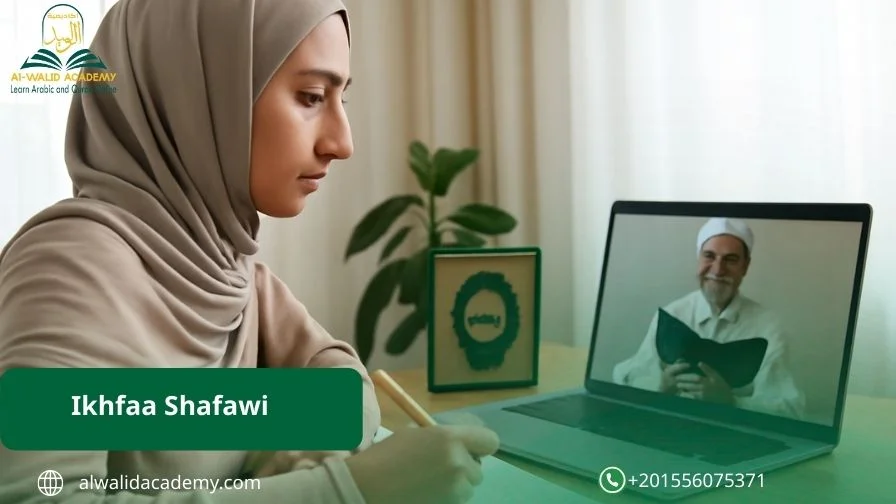Why are Quranic examples of ikhfaa shafawi so crucial to understanding Tajweed, and what does it imply exactly? Have you ever pondered the finer points of reciting the Quran? How does "ikhfa" appear in the Quran, and what does it mean exactly? That's all we will know on this topic.
Ikhfaa Shafawi
Al Ikfha is linguistically defined as masking, hiding, or disappearing from the Arabic term Ikhfaa.
Al Ikhfaa means to pronounce a letter entirely aloud or partially silently. Stated differently, Ikhfaa represents a compromise between Izzhar's and Idghaam's reigns. Alphabetically, al-Meem Es-sakinah (ْم) is associated with al Ikhfaa Ash Shafawi. Al-Ikhfaa Ashafawi's letters are all one letter. The letter (ب) is it.
Therefore, we may describe Al-ikhfaa Esh-shafawias as follows: the reciter of the Holy Quran shall fulfill Ghunna (a nasal sound) for two seconds, and Al-meem Es-Sakinah should be veiled or concealed if the letter (ب) comes after it. It is important to remember that Al-Ghunna of Iqalb and Al-Ikfha Ash-Shafawi are both adherents of the same Ghunnah.
It should be noted that only when two words are employed does Al-Ikhfa Ash-Shafawi appear.
What Makes The Ikhfaa Shafawi?
If Al-Meem Sakinah were followed by the letter (ب), it would be Al-Ikhfaa Ashafawi. Two seconds of the Holy Quran should be recited when Ghunnah appears.
Regarding the question of how this Ghunnah should be completed, the experts disagreed. When reciting Al-Meem Es-sakinah, the reciter of the Holy Quran should keep their mouth slightly open and refrain from touching their lips, according to certain scholars and reciters.
According to other academics and reciters, the lips should contact and the mouth should be closed. This has some resemblance to the Iqlaab rule. As a result, we hear certain reciters of the Holy Quran use similar or distinct systems to meet the requirements of Al-Ikhfaa Ashafawi and Iqlaab.
Ikhfa Shafawi Letters
Al-Ikhfaa Shafawi's letters are four in number. According to the Ikhfa Shafawi norm, the following letters are included:
-
(Ba') ب
-
(Fa') ف
-
(Mim) م
-
(Waw) و
The Mim م sound becomes considerably nasalized when any of the aforementioned letters are followed by the Mim (م). The articulation of the following letter is somewhat "hidden," fusing the Mim's sounds with the one that follows.
As an illustration:
-
م ب (Mim + Bā’) is pronounced with a nasal "M," in which the "B" is blended with the "M" rather than fully pronounced.
-
A soft F sound follows a similar nasalized M sound in م ف (Mim + Fa').
How Do We Pronounce Ikhfaa Shafawi?
There are two ways to pronounce Al-Ikhfaa Ashafawi. Let's investigate them below:
-
Make the nasal sound (Ghunnah) for two Harakat while keeping your mouth closed.
-
Keep the nasal sound "Ghunnah" while closing your lips with a small gap between them for the second Harakat.
Why Was Al-Ikhfaa Ash Shafawi Named With That Name?
One of the goals of Shifah is to spread the news about Shafawi.
Al-Ikhfaa Ash Shafawi's name, according to some academics, comes from the fact that the letters Meem (م) and Baa (ب) have the same or a similar point of articulation (Makhraj). Meaning they are both spoken from the lips.
Speaking again, there are two reasons why Al-Ikhfa' Ash-Shafawi was given this name:
-
It means "blending" or "concealment." Ikhfa' (إخفاء). The Mim (م), rather than being fully articulated, is nasally spoken and combined with the subsequent letter.
-
Ash-Shafawi (الشَّفَوي): Describes labial (lip-pronounced) letters, such Mim (م), Waw (و), Fa' (ف), and Ba' (ب).
Thus, hiding of the Mim sound when labial letters are used after it is what Al-Ikhfa' Ash-Shafawi signifies.
Read about: Idgham Shafawi
Ikhfa Shafawi Examples In the Quran
There are several instances of Al-Ikhfaa Ashafawi throughout the Quran, including:
As stated by God Almighty in Surah Al-Baqarah:
-
(أَنبِئْهُم بِأَسْمَائِهِمْ)
-
(فلمّا أَنبَأَهُم بِأَسْمَائِهِمْ)
-
(وَفِي ذَلِكُم بَلَاءٌ)
-
(خذوا ما آتَيْنَاكُم بِقُوَّةٍ)
Here are some more examples of Al-Ikhfaa Ashafawi in the Holy Quran:
-
(الَّذِي أَطْعَمَهُم مِّن جُوعٍ وَآمَنَهُم مِّنْ خَوْفٍ) - Surah Quraish
-
(أَلَا يَظُنُّ أُولَئِكَ أَنَّهُم مَّبْعُوثُونَ) - Surah Al-Mutaffifin
-
(إِنَّهَا عَلَيْهِم مُّؤْصَدَةٌ) - Surah Al-Humazah
-
(أَلَمْ نَخْلُقكُّم مِّن مَّاء مَّهِينٍ) - Surah Al-Mursalat
-
(وَاللَّهُ مِن وَرَائِهِم مُّحِيطٌ) - Surah Al-Buruj
The Ghunnah Of Ikhfaa Shafawi
Ghunnah is a soft sound produced by the nostrils without the tongue being used. The movement, which is equivalent to a person gripping or extending his finger, determines its range or duration without hurry or delay.
When the silent Meem (م) comes into contact with the letter baa (ب), whether in a single word or two syllables, it is concealed, giving rise to the Ghunnah in Ikhfaa Shafawi, as in the Almighty's statement: (يَعْتَصِم بِاللَّهِ), for instance.
Two movements in Ikhfaa Shafawi expand the Ghunnah.
Learn Quran, Arabic, and Islamic Studies with certified teachers in fun, interactive, and personalized sessions. Join thousands of students around the world and begin your path today!
What Is The Difference Between Ikhfaa Shafawi And Ikhfaa Haqiqi?
The primary distinction between Ikhfaa Shafawi and Ikhfaa Haqiqi is the significance of each and how it is pronounced.
The first difference
If one of the fifteen letters of Al-Ikhfaa comes after An-noon Es-Sakinah or At-tanween, then Ikhfaa Haqiqi is employed to hide them.
But when the letter (ب) Baa or meem (مْ) comes after Al-Meem Es-sakinah, the sound of Al-ghunnah, which is perceived as two beats, is momentarily maintained while being covered by Ikhfaa Shafawi, as in the examples below:
(تَرْمِيهِم بِحِجَارَةٍ - وَهُم بِالْآخِرَةِ)
The Second difference
The use of certain Tajweed knowledge letters is another way that Ikhfaa Haqiqi and Ikhfaa Shfawi differ from one another.
There are fifteen Arabic letters in all. After An-noon Es-Sakinah or At-tanween, one of these fifteen letters is used to produce the Al Ikhfaa Al Haqiqi.
Look for one of the fifteen letters, and you will see An-noon Es-Sakina. Next, we must conceal the An-noon sound and do Al-Gunna for around two seconds.
Al-Ikhfaa Al-Haqiqi's fifteen Arabic letters are as follows:
- ت
- ث
- ج
- د
- ذ
- ز
- س
- ش
- ص
- ض
- ط
- ظ
- ف
- ق
- ك
- What Is The Difference Between Ikhfaa Shafawi And Idgham Shafawi?
What Is The Difference Between Ikhfaa Shafawi And Idgham Shafawi?
The labial merger of one letter into another is indicated by Idgham Shafawi.
Another name for this type of Idgham is "Idgham Mithlien Sagherien" (the little, comparable letters).
To produce a single, accentuated sound, the Arabic letter Al-Meem Es-sakinah should be coupled with the voiced meem when it appears before another voiced meem. In conclusion:
Ikhfaa Shafawi
Ikhfaa is masking or stifling the sound of Tanween or Noon Sakinah with a faint nasal sound.
When the letter that follows Noon Sakinah or Tanween does not fit within one of the categories of Izhaar, Idgham, or Iqlaab, it is called Ikhfaa.
Ghunnah is used when performing ikhfaa. Instead of being spoken clearly, the sound of Noon Sakinah or Tanween is gradually blended with the subsequent letter to produce a nasalized sound.
Idgham is the process of combining the Idgham letter with Noon Sakinah or Tanween to create the Mushaddad letter, a single, lengthy consonant sound.
Idgham Shafawi
Idgham occurs when Noon Sakinah or Tanween is followed by one of these six letters: Yaa (ي), Raa (ر), Meem (م), Laam (ل), Waw (و), or Noon (ن).
Depending on the particular regulations, idgham can be conducted with or without ghunnah. The combined sound may be nasalized or it may be pronounced without nasalization.
Read about: Idgham in Tajweed
Learn Quran, Arabic, And Islamic Studies Online
Anyone who wants to study and comprehend the Arabic language of the Quran may take advantage of our online Quran classes. We start by giving a brief overview of each Surah (or section).
This will provide you with a thorough grasp of Surah and a historical perspective on each chapter. As a result, for every chapter portion, we give students an interactive learning website.
Enroll in our online programs for Quran, Arabic, and Islamic studies course to embark on an enlightening journey. With a genuine and individualized learning method, our native Arabic instructors, who are fluent in English, including several Al-Azhar-certified teachers, offer an outstanding experience.
The Way We Operate
-
Choose a Course
Choose the best Quran, Arabic, or Islamic Studies course for your ability, objectives, and schedule from a variety of customizable alternatives for families, adults, and Quran lessons for kids online.
-
Assign Students to Teachers
For a tailored, successful learning experience, find a licensed instructor who most closely matches your learning preferences, objectives, and timetable.
-
Start Your Online Education
From the convenience of your home, begin studying online with live, interactive sessions taught by knowledgeable professors.
-
Certificates & Reports
As you finish your courses, receive reports, track your progress at every stage, and receive certifications.
Alwalid Academy offers an Online Noorani Qaida Course, Quran lessons for Kids online, and online Quran classes for Adults. Native Arab tutors will be teaching the programs.
Read about: How to Learn Quran with Tajweed at Home
Conclusion
According to Tajweed, Shafawi means to keep the nasal sound (ghunnah) for around two seconds while hiding the sound of the letter Al-Meem Es-sakinah (م) when it is followed by the letter (ب) in the Quran. Its name refers to the way the lips are articulated when pronouncing words.
This is different from Ikhfaa Haqiqi, which is hiding An-noon Es-Sakinah or At-tanween when certain letters follow.
To be able to recite the Holy Quran fluently and obtain a good ranking in the afterlife, every Muslim should make every effort to master Tajweed.
Contact Alwalid Academy now and you will find the courses what you need,
FAQs
What is the letter of Al-Ikhfaa El-Shafawi?
Al-Ikhfaa El-Shafawi has only one letter, which is the letter “baa” “ب”.
What are the rules of Shafawi?
The rules of Shafawi in Tajweed include keeping the nasal sound (ghunnah) for around two seconds while hiding the sound of the letter Al-Meem Es-sakinah when it is followed by the letter (ب).
What is the difference between Iqlab and Ikhfa Shafawi?
Iqlab is the alteration of noon sakin or tanwin into a mim sakin if the letter ba comes after it. Al-Ikhfaa El-Shafawi is the concealment of the mim sakin if a ba comes after it.
What is Shafawi in Arabic?
The word Shafawi refers to lips in Arabic.


